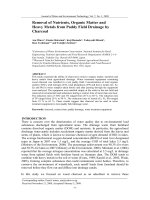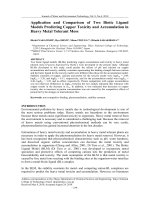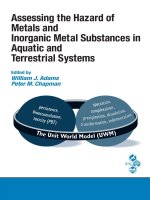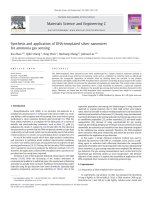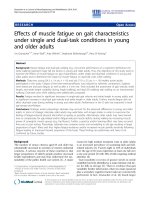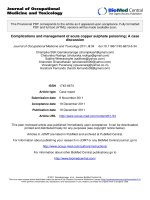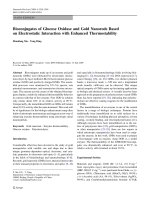- Trang chủ >>
- Khoa Học Tự Nhiên >>
- Vật lý
MELTING OF METALS COPPER, SILVER AND GOLD UNDER PRESSURE
Bạn đang xem bản rút gọn của tài liệu. Xem và tải ngay bản đầy đủ của tài liệu tại đây (271.22 KB, 5 trang )
Proc. Natl. Conf. Theor. Phys. 35 (2010), pp. 148-152
MELTING OF METALS COPPER, SILVER AND GOLD
UNDER PRESSURE
PHAM DINH TAM
Le Quy Don University of Technology, 100 Hoang Quoc Viet, Cau Giay, Hanoi
PHAM DUY TAN
College of Armor, Tam Dao, Vinh Phuc
NGUYEN QUANG HOC
Hanoi National University of Education, 136 Xuan Thuy, Cau Giay, Hanoi
PHUNG DINH PHONG
Hanoi University of Education No.2, Me Linh, Hanoi
Abstract. The dependence of the melting temperature of metals Cu, Ag and Au on pressure in
the interval from 0 to 40 kbar is studied by the statistical moment method. This dependence has
the form of near linearity and the calculated slopes of melting curve are 3.9 for Cu, 5.7 for Ag
and 6 for Au. These results are in good agreement with the experimental data.
I. INTRODUCTION
The melting of crystals is a popular phenomenon in nature and is generated at
high temperature. Many research methods are developed in studying the melting process
of crystal, where there are two different basic approaches. According to the first way
of approach, the melting happens when the free energy of solid phase is equal to the
one of liquid phase. With this way of approach, it is necessary to know the structure
of both phases. However, the structure of liquid phase is very complex and usually is
limited like pseudocrystal. The second way of approach for melting of crystal relates to the
instability of solid phase. Many theories in this direction are applied such as the vibrational
theory, the thermodynamic theory, the mechanical theory, etc. [1, 2]. Nevertheless, these
theoretical results fully do not describe the melting curve of crystal. A study on the melting
of crystal under pressure (the melting curve) has been attracted researchers attention and
there are many methods applied in studying this problem [3, 4, 5].
In this paper, the dependence of melting temperature on pressure for metals Cu, Ag
and Au is investigated by the statistical moment method. Our obtained simple equations
rather well describe quantitatively the above mentioned dependence.
II. MELTING CURVE
Applying the Lindermann hypothesis, we find the equation for melting curve from
the following condition:
u2
= δL ,
(1)
a2
MELTING OF METALS COPPER, SILVER AND GOLD UNDER PRESSURE
149
where u2 and a are the mean square displacement and the lattice parameter at the
melting temperature, respectively and δL is the Lindermann parameter. From the result
obtained in [6], we have:
u2 =
2
θm
γ 0 θm
θ m γ 0 θm
+ 3 =
1+ 2
,
k0
k0
k0
k0
(2)
where θm = kB Tm ; k0 , γ0 are the coefficients depending on pressure [7]. Substituting (2)
into (1), we obtain the following equation:
θm
γ 0 θm
1+ 2
2
k0 a
k0
= δL .
(3)
Using the Lennard-Jones potential (n-m) [9]:
ϕ(a) =
we find:
k0 =
n
D
r0
m
n−m
a
DmnB1
(n − m)a20
r0
a0
n
1−
r0
a
m
−n
B2
B1
a0
r0
(n−m)
,
(4)
,
(5)
DmnA1
r0 n
A2 a0 (n−m)
1
−
,
(6)
A1 r0
(n − m)a40 a0
25
2
25
2
where B1 = n − 1; B2 = m − 1; A1 = n3 + 3n2 + n + 10; A2 = m3 + 3m2 + m + 10; r0
3
3
3
3
is the equilibrium distance between two atoms when they stand independently, a0 < r0 .
The lattice parameter a is determined from [6, 8]. Here, we approximately consider this
parameter in the form:
γ0
a = a0 + θ
.
(7)
k03
Substituting (5), (6) and (7) into (3), we obtain the following equation for the melting of
crystal:
γ0 =
2
θm
A1
AB12
2B2 A2
−
B1
A1
+
1
A
A1
B13
A2 3B2
−
A1
B1
2
y 3n−m + θm
A1
2
−
2
A
AB1
A1 2n
y
B13
+ θm y n + AB2 δL y n−m − AB1 δL = 0, (8)
Dmn
a0
and y = . The quantity y is determined from the equation of state
n−m
r0
for crystal at temperature T = 0 K and pressure p [6] as follows:
where A =
−pδa20 =
1 ∂u(a0 )
1 ∂k0
+ √
,
6 ∂a
4 M k0 ∂a
(9)
where u(a0 ) is determined in [7], M is the mass of atom, δ is the coefficient depending
on the structure of crystal. From (5), (6) and (9), we calculate the equation of state for
crystal at temperature T = 0K and pressure p according to variables p and y.
150
PHAM DINH TAM, PHAM DUY TAN, NGUYEN QUANG HOC...
III. EQUATIONS FOR MELTING CURVE OF METALS COPPER,
SILVER AND GOLD UNDER PRESSURE
Values of potential parameters D, r0 , n and m for metals Cu, Ag and Au are taken
from [9] and are summarized in Table 1.
Table 1. Parameters D, r0 , n and m for metals Cu, Ag and Au
Metals
Cu
Ag
Au
˚)
D/kB (K) r0 (A
n
m
3401,0
2,5487 9,0 5,5
3325,6
2,8760 9,5 5,5
4683,0
2,8751 10,5 5,5
Substituting these values into (8) and (9), we find the equations for curve of melting
of metals Cu, Ag and Au under pressure.
III.1. Equation for melting curve of Cu under pressure
This equation has the form:
2 18
2, 12.10−4 Tm
y (1 + 0, 84y 3,5 ) + Tm y 9 + 2246, 4y 3,5 − 4004 = 0,
(10)
where y is determined by the equation of state as follows:
0, 0095py 12 − 0, 039y 10,5 + 0, 242y 7 + 9, 973y 3,5 − 9, 83 = 0.
(11)
Solutions of Eqs. (10) and (11) at different pressures are given in Table 2
Table 2. Solutions of Eqs. (10) and (11) at different pressures
p(Kbar)
0
10
20
30
40
∆T /∆p
y
0,9901 0,9878 0,9855 0,9834 0,9814
Tm (K) 1358,4 1398,5 1439,5 1478 1515,6
4,0
III.2. Equation for melting curve of Ag under pressure
This equation has the form:
2 19
2, 3.10−4 Tm
y (1 + 0, 85y 4 ) + Tm y 9,5 + 1774, 5y 4 − 3358 = 0,
(12)
where y is determined by the equation of state as follows:
0, 0152py 12,5 − 0, 024y 11,75 + 0, 157y 7,75 + 9, 33y 4 − 0, 256y 3,75 − 8, 85 = 0.
Solutions of Eqs. (12) and (13) at different pressures are given in Table 3
Table 3. Solutions of Eqs. (12) and (13) at different pressures
p(Kbar)
0
10
20
30
40
∆T /∆p
y
0,9901 0,9865 0,9832 0,9801 0,9772
Tm (K) 1235,9 1295,9 1353,2 1409,3 1463,6
5,7
(13)
MELTING OF METALS COPPER, SILVER AND GOLD UNDER PRESSURE
151
III.3. Equation for melting curve of Au under pressure
This equation has the form:
2 21
2, 82.10−4 Tm
y (1 + 0, 55y 5 ) + Tm y 10,5 + 1582, 2y 5 − 3346, 6 = 0,
(14)
where y is determined by the equation of state as follows:
0, 0213py 13,5 − 0, 019y 14,25 + 0, 137y 9,25 + 11, 62y 5 − 0, 243y 4,25 − 10, 96 = 0.
(15)
Solutions of Eqs. (14) and (15) at different pressures are given in Table 4
Table 4. Solutions of Eqs. (14) and (15) at different pressures
p(Kbar)
0
10
20
30
40
∆T /∆p
y
0,9905 0,9873 0,9842 0,9814 0,9788
Tm (K) 1336,9 1398,6 1460,9 1519,4 1575,6
6,0
IV. DISSCUSION OF OBTAINED RESULTS
IV.1. Qualitative investigation
From Eqs. (11), (13) and (15) we derive the clear dependence of p on y. Functional
investigation shows that when p increases, y decreases (with y < 1).
Eqs. (10), (12) and (14) are the equation of the second degree according to Tm with
the coefficients depending to the parameter y. Positive solution Tm obtained from these
equations depends on the parameter y and shows that when y decreases (i.e. p increases),
Tm increases.
IV.2. Quantitative investigation
Results of investigating the pairs of equation (10) and (11), (12) and (13), (14) and
(15) in the interval of pressure from 0 to 40 kbar are represented in Figure 1. The detailed
results are given in numerical tables.
Three obtained melting curves approximately have the form of straight lines with
different slopes. The calculated mean slopes of melting curves are 3.9 for Cu, 5.7 for Ag
and 6.0 for Au. These results are in very good agreement with the experimental data [10].
In conclusion, our obtained results on the equations of melting curve for metals
Cu, Ag and Au (the pairs of equation (10) and (11), (12) and (13), (14) and (15)) have
simple analytic forms and rather well describe the melting of metals.
REFERENCES
[1]
[2]
[3]
[4]
[5]
[6]
J. Shanker, M. Kumar, Phys. Stat. Sol. (b) 158 (1990) 11.
N. R. Mistra et al., Phys. Rev. 161 (1967) 613.
B. Grabwski et al., Phys. Rev. B 79 (2009) 134106.
L. Koci et al., Jour. of Phys. 121 (2008) 012005.
Weingarten, N. Scott Mattson et al., Jour. of Appl. Phys. 106 (2009) 063524.
Nguyen Tang, Vu Van Hung, Phys. Stat. Sol. (b) 149 (1988) 149; 161 (1990) 165; 162 (1990) 371;
162 (1990) 379.
[7] Pham Dinh Tam, VNU. Jour. of Sci. 2 (1999) 35.
[8] K.Masuda-Jindo, Vu Van Hung, Pham Dinh Tam, Phys. Rev. B 9 (2003) 094301.
152
PHAM DINH TAM, PHAM DUY TAN, NGUYEN QUANG HOC...
Fig. 1. The melting temperature of Cu, Ag and Au at various pressures
[9] Shuzen, G. J. Davies, Phys. Stat. Sol. (a) 78 (1983) 595.
[10] Lewish Cohen et al., Phys. Rev. 145 (1996) 519.
Received 10-10-2010.
